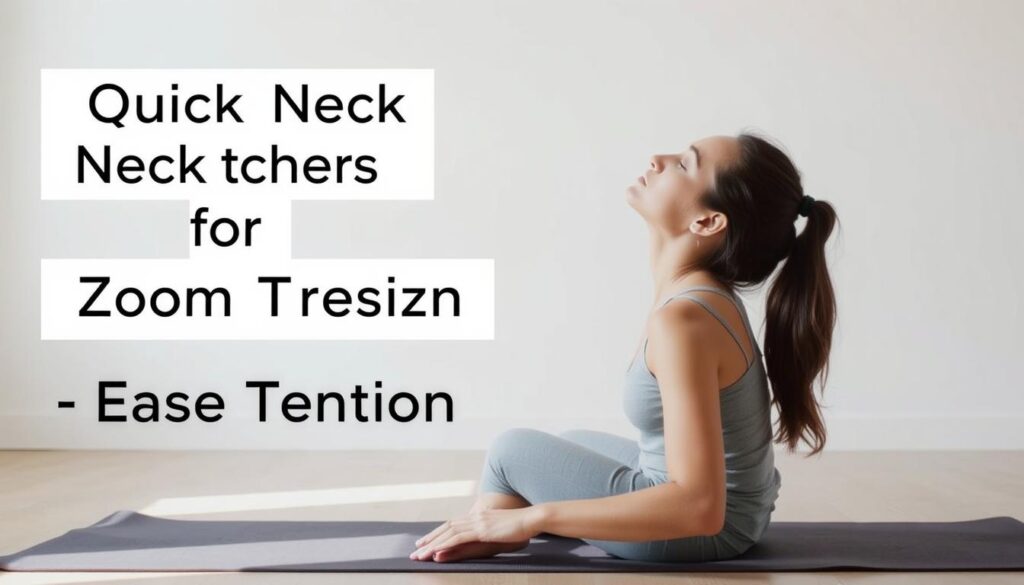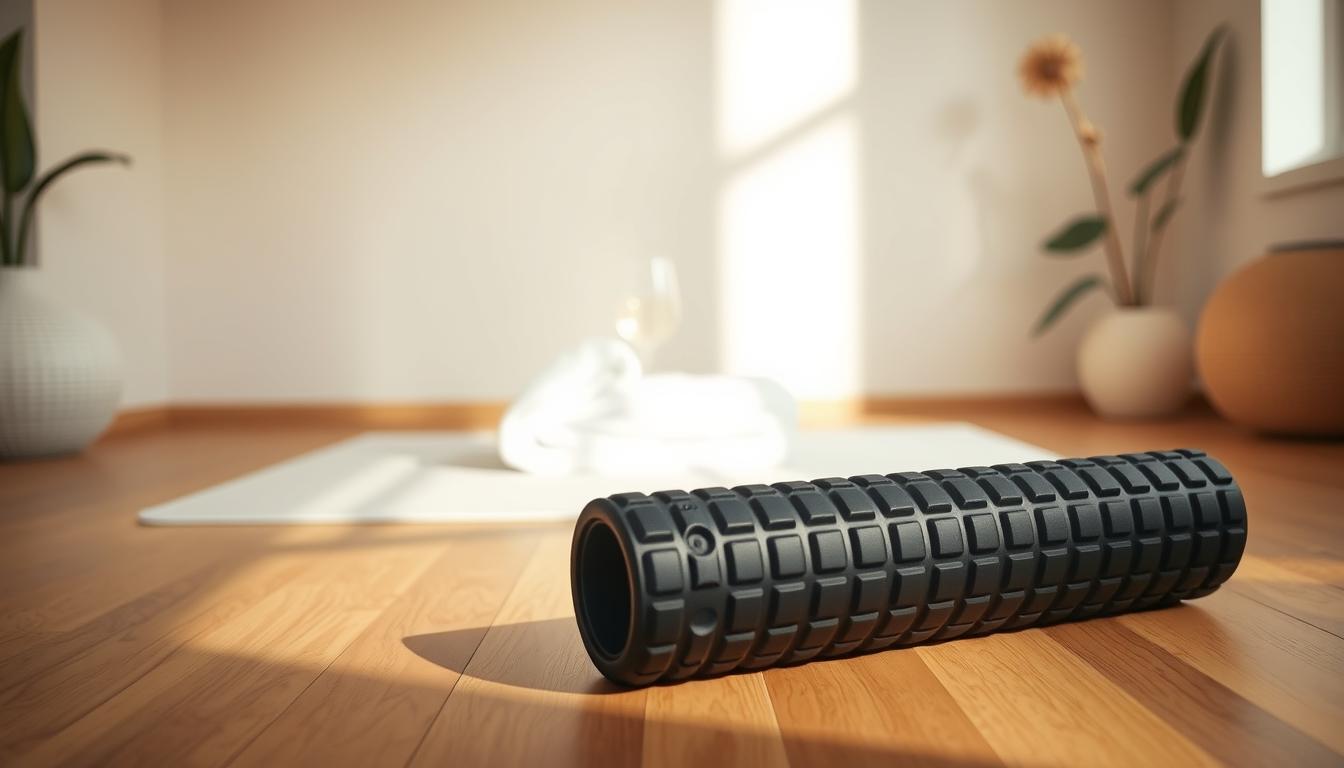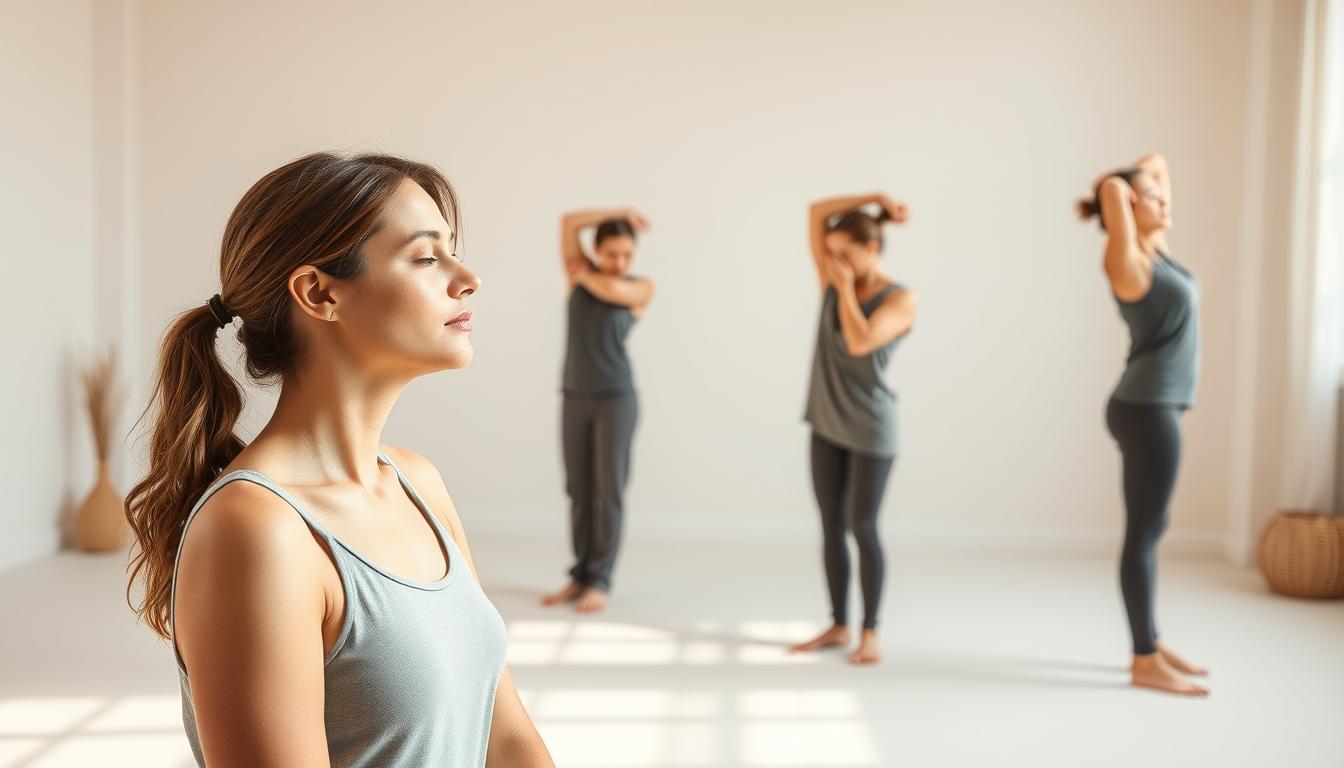Today’s world has us in virtual meetings for long hours, causing neck pain. Taking frequent Zoom breaks? Quick neck stretches are key. They help with tension from too much screen time, making you feel and work better. Add these easy exercises to your day to fight neck pain and boost your productivity.
Understanding Neck Tension in the Digital Age
Nowadays, many people spend roughly seven hours a day looking at screens. This habit can cause neck tension. It comes from not sitting right and poor posture while using devices.
Impact of Screen Time on Neck Health
Looking down at devices makes the spine align wrong. This not just makes the neck hurt. It also causes stiffness in the upper back and shoulders.
Staying in these bad positions often makes things worse. So, it’s important to know how to keep your neck healthy today.
What is Text Neck?
Text neck is what we call the damage done by always bending over to see our devices. It’s not officially a disease, but it’s a big problem for users of tech.
This issue makes neck muscles tight and messes up spine alignment. And, it can make posture problems even worse as time goes by.
Signs You Need Neck Stretches
Knowing when you need neck stretches is key for your neck’s well-being. Many people have neck pain and discomfort but don’t realize it’s from neck strain. If you know the symptoms, you can find the right way to get relief and know when it’s time to get help.
Common Symptoms of Neck Strain
Neck strain shows itself in different ways. Here are the usual symptoms:
- Chronic discomfort in the neck area
- Stiffness that limits mobility
- Reduced range of motion
- Headaches that start in the neck
- Pain that spreads to the shoulders or arms
These issues often get worse with too much screen time, common in today’s digital world. It’s crucial to take steps to improve your neck health.
When to Seek Medical Attention
Not every neck pain needs a doctor right away. But, some situations require a professional look. Get help if:
- The symptoms don’t go away for a long time
- The pain gets worse, even with self-care
- You have severe headaches or migraines
- The pain moves down into your arms
Acting on these warnings can help you tackle any deeper problems effectively.
Benefits of Quick Neck Stretches
Quick neck stretches in your daily routine offer many benefits for your well-being. They ease tension and improve your posture. They also help you focus better and reduce stress.
Improving Posture
Stretching your neck regularly helps improve your posture. It counters the bad effects of sitting too long or staring at screens. These stretches help keep your neck’s natural curve. This leads to better spine alignment.
Enhancing Concentration and Focus
Doing quick neck stretches can help you concentrate and focus better. Muscle tension can distract you from your work. Simple stretches can relieve this tension. This makes clear thinking and higher productivity easier.
Reducing Stress and Anxiety
Neck stretches can also help you feel less stressed. Stretching releases endorphins, which reduce muscle tightness and bring calm. This is especially helpful during busy and anxious times at work.
Quick Neck Stretches Between Zoom Meetings
Sitting for long periods during Zoom meetings can cause neck pain. Adding desk stretches to your day can help. Quick stretches can make your neck and shoulders feel better. This makes you feel more relaxed overall. Try some easy stretches when you take breaks from video calls.
Stretching Exercises You Can Do at Your Desk
Short stretches while sitting can ease your pain. Here are some you can do:
- Shoulder Shrugs: Lift your shoulders towards your ears, hold for a moment, and release.
- Neck Rotations: Gently rotate your neck in circular motions, switching directions.
- Lateral Neck Stretches: Tilt your head towards one shoulder, holding for a few seconds, then switch sides.
- Gentle Neck Tilts: Lower your chin to your chest and then tilt your head back slowly.
Incorporating Movement into Your Day
Mixing work with movement is key. Reminding yourself to move helps you not forget. Try to move a little every hour to refresh yourself. Moving around, even just a little, helps reduce stiff muscles. It also helps you focus better in meetings.
Shoulder Release Technique
The shoulder release technique is a great way to ease tension in your neck and shoulders. It’s perfect for those who spend a lot of time at a desk or staring at screens. By stretching this way, you can take better care of your neck.
Start by sitting straight in your chair. Pull your shoulder blades down and back until they feel relaxed. This not only makes your posture better but also eases muscle tension.
Adding this technique to your day can make you feel a lot more comfortable. Try doing it a few times a day to keep tension away.
Neck Rotation Stretches
Adding neck rotation exercises to your day can really help your neck feel better. It makes sure your neck and spine line up right. This makes you more flexible and helps ease any tightness. Doing these regularly can also help your neck blood flow better. This means less stiffness from sitting too long.
How to Perform Neck Rotations
Here’s a quick guide on doing neck rotations:
- Start sitting comfortably with your back up straight.
- Gently turn your head to the right, trying to touch your shoulder with your chin.
- Stay like this for a bit, feeling your neck stretch.
- Then, go back to the center and do the same to the left.
- Do this several times on both sides. Keep your movements smooth.
Benefits of Neck Rotations
The perks of doing neck rotations are many. Doing them often can:
- Make your neck area more flexible.
- Help get rid of tension from daily life.
- Boost blood flow, which makes your neck work better.
- Lower the soreness from sitting too much.
Lateral Neck Stretch
The lateral neck stretch helps ease pain from tightness in your neck’s sides. It makes your neck more flexible and less painful. It’s a great stretch to add to your daily activities.
To do a lateral neck stretch, gently move your head towards one shoulder. Keep the other shoulder relaxed. You should feel a gentle stretch on your neck’s side. Then, do the same on the other side to keep things even.
Adding lateral neck stretches to your day helps loosen tension from long screen time. Doing these stretches often keeps your neck healthy and comfy.
Forward and Backward Neck Tilt
Neck tilt exercises are a great way to relax and make your neck more flexible. Doing both forward and backward tilts can ease pain and help your neck feel better. These easy movements keep your neck’s natural shape, improving its health.
It’s important to move slowly and gently during these exercises to avoid getting hurt. Adding these tilts to your everyday activities can really help your neck stay healthy. Let’s look at what benefits they offer:
- Encourages flexibility in the neck muscles.
- Reduces muscle tension caused by too much screen time.
- Aids in keeping the neck properly aligned.
- Promotes relaxation and improves overall mood.

Chair Lean and Back Stretch
The chair lean and back stretch help ease neck and upper back tension. They’re great during a workday filled with Zoom calls and lots of sitting. By using your chair, you can get a good stretch without even standing up.
Here’s how to do a chair stretch while you’re sitting:
- Adjust your chair so that your feet are flat on the floor.
- Lean back gently against the chair, keeping your spine straight.
- Extend your arms overhead and interlace your fingers.
- Gently lean to one side, feeling the stretch along your side and back.
- Hold for 15-30 seconds, switch sides, and repeat.
Adding this back stretch to your day can boost your flexibility and comfort. It’s a quick way to refresh without cutting into your work time. This makes your workspace nicer and less stressful.
Making Time for Regular Stretch Breaks
Adding stretch breaks during the workday helps keep everyone healthy and happy. It’s important to remind ourselves to stretch to avoid physical discomfort and stay sharp. These breaks help us refresh our bodies and minds.
Setting Reminders for Stretching
To remember to stretch regularly, setting reminders is helpful. You can use your phone or computer to alert you during the day. These reminders make it easy to take short breaks for stretching, helping us form good habits.
- Use calendar reminders to schedule stretch breaks.
- Download apps designed to encourage reminders to stretch.
- Place sticky notes around your workspace as visual cues.
Creating a Stretching Routine
Having a set routine for stretching ensures you do it regularly. Crafting a sequence of stretches tailored to your needs makes it simpler to remember and do. Here are some tips to build your stretching habit:
- Select specific stretches that target areas of tension.
- Incorporate stretches that can be done comfortably at your desk.
- Commit to a specific time each day to perform your routine, like during a lunch break or between meetings.
Combining Breathing Exercises with Stretching
When you mix breathing exercises with stretching, it boosts relaxation. Doing both at the same time lets you clear your mind and relax your body. This approach improves your stretching and is good for your overall health.
To get the most out of this combination, here are some tips:
- Inhale deeply through the nose as you prepare for a stretch.
- Exhale slowly through the mouth while deepening the stretch.
- Focus on the rhythm of your breath to stay connected to your body.
Adding these methods to your daily life can better your mood and reduce stress. Paying attention to your breathing while stretching taps into mindful movement. This leads to even deeper relaxation.
Conclusion
Doing quick neck stretches is crucial for easing neck tension, especially if you’re always on Zoom meetings. These easy exercises help with discomfort and boost your wellness at work. Stretching a bit each day makes your workspace better and more productive.
Knowing why stretching matters helps keep your posture good and lowers stress during work. When you stretch regularly, your work environment becomes more comfy. This helps you focus and do better at your job.
Adding these quick neck stretches to your day brings lasting benefits for your neck and overall health. Making movement a regular thing is a big step in avoiding pain. It also leads to a healthier, more lively work life.



